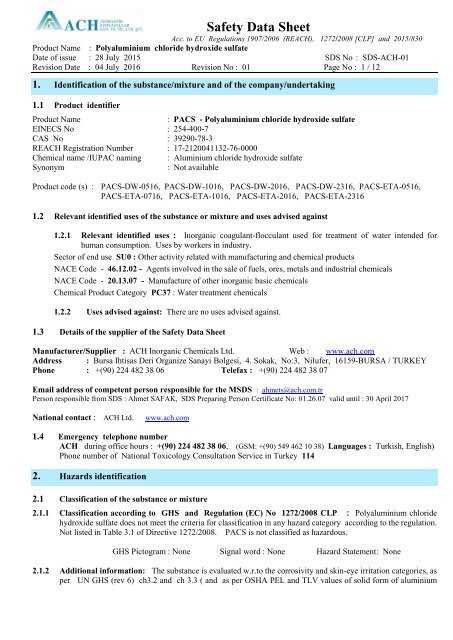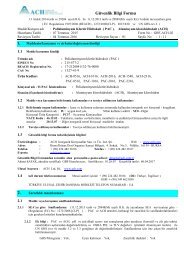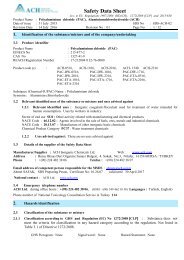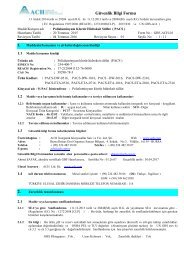PACS MSDS EN
Create successful ePaper yourself
Turn your PDF publications into a flip-book with our unique Google optimized e-Paper software.
Safety Data Sheet<br />
Acc. to EU Regulations 1907/2006 (REACH), 1272/2008 [CLP] and 2015/830<br />
Product Name : Polyaluminium chloride hydroxide sulfate<br />
Date of issue : 28 July 2015 SDS No : SDS-ACH-01<br />
Revision Date : 04 July 2016 Revision No : 01 Page No : 1 / 12<br />
1. Identification of the substance/mixture and of the company/undertaking<br />
1.1 Product identifier<br />
Product Name<br />
: <strong>PACS</strong> - Polyaluminium chloride hydroxide sulfate<br />
EINECS No : 254-400-7<br />
CAS No : 39290-78-3<br />
REACH Registration Number : 17-2120041132-76-0000<br />
Chemical name /IUPAC naming : Aluminium chloride hydroxide sulfate<br />
Synonym<br />
: Not available<br />
Product code (s) : <strong>PACS</strong>-DW-0516, <strong>PACS</strong>-DW-1016, <strong>PACS</strong>-DW-2016, <strong>PACS</strong>-DW-2316, <strong>PACS</strong>-ETA-0516,<br />
<strong>PACS</strong>-ETA-0716, <strong>PACS</strong>-ETA-1016, <strong>PACS</strong>-ETA-2016, <strong>PACS</strong>-ETA-2316<br />
1.2 Relevant identified uses of the substance or mixture and uses advised against<br />
1.2.1 Relevant identified uses : Inorganic coagulant-flocculant used for treatment of water intended for<br />
human consumption. Uses by workers in industry.<br />
Sector of end use SU0 : Other activity related with manufacturing and chemical products<br />
NACE Code - 46.12.02 - Agents involved in the sale of fuels, ores, metals and industrial chemicals<br />
NACE Code - 20.13.07 - Manufacture of other inorganic basic chemicals<br />
Chemical Product Category PC37 : Water treatment chemicals<br />
1.2.2 Uses advised against: There are no uses advised against.<br />
1.3 Details of the supplier of the Safety Data Sheet<br />
Manufacturer/Supplier : ACH Inorganic Chemicals Ltd. Web : www.ach.com<br />
Address : Bursa Ihtisas Deri Organize Sanayi Bolgesi, 4. Sokak, No:3, Nilufer, 16159-BURSA / TURKEY<br />
Phone : +(90) 224 482 38 06 Telefax : +(90) 224 482 38 07<br />
Email address of competent person responsible for the <strong>MSDS</strong> : ahmets@ach.com.tr<br />
Person responsible from SDS : Ahmet SAFAK, SDS Preparing Person Certificate No: 01.26.07 valid until : 30 April 2017<br />
National contact : ACH Ltd. www.ach.com<br />
1.4 Emergency telephone number<br />
ACH during office hours : +(90) 224 482 38 06, (GSM: +(90) 549 462 10 38) Languages : Turkish, English)<br />
Phone number of National Toxicology Consultation Service in Turkey 114<br />
2. Hazards identification<br />
2.1 Classification of the substance or mixture<br />
2.1.1 Classification according to GHS and Regulation (EC) No 1272/2008 [CLP] : Polyaluminium chloride<br />
hydroxide sulfate does not meet the criteria for classification in any hazard category according to the regulation.<br />
Not listed in Table 3.1 of Directive 1272/2008. <strong>PACS</strong> is not classified as hazardous.<br />
GHS Pictogram : None Signal word : None Hazard Statement: None<br />
2.1.2 Additional information: The substance is evaluated w.r.to the corrosivity and skin-eye irritation categories, as<br />
per UN GHS (rev 6) ch3.2 and ch 3.3 ( and as per OSHA PEL and TLV values of solid form of aluminium
Safety Data Sheet<br />
Acc. to EU Regulations 1907/2006 (REACH), 1272/2008 [CLP] and 2015/830<br />
Product Name : Polyaluminium chloride hydroxide sulfate<br />
Date of issue : 28 July 2015 SDS No : SDS-ACH-01<br />
Revision Date : 04 July 2016 Revision No : 01 Page No : 2 / 12<br />
soluble salts ) and evaluated by using “pH and acid/alkaline reserve test” results, and found no prevailing<br />
hazard category.<br />
Information pertaining to particular dangers for man and environment : The substance is in liquid state and it is<br />
used as coagulant in drinking water treatment facilities.<br />
Other hazards which do not result in classification : As per Standard <strong>EN</strong> 883 (2004) : Xi: Irritant, R36. (EU<br />
Directive 67/548/EEC is not in force since 01 June 2015) – as per 1272/2008 Eye irritation category 2, H319.<br />
2.2 Label elements : Labeling according to Regulation (EC) No 1272/2008 (and as per UN GHS rev. 6 )<br />
Polyaluminium chloride hydroxide sulfate (<strong>PACS</strong>)<br />
P264, P280, P(305+351+338)<br />
Hazard Statements : No hazard statement assigned<br />
Precautionary Statement Prevention :<br />
P264 - Avoid breathing dusts<br />
P280 – Wear protective gloves/protective clothing/eye protection.<br />
Precautionary Statement Response :<br />
(P305+351+338) – IF IN EYES: Rinse cautiously with water for several minutes. Remove contact lenses, if present and<br />
easy to do. Continue rinsing.<br />
Precautionary Statement Storage : None<br />
Precautionary Statement Disposal : None<br />
2.3 Other hazards: <strong>PACS</strong> does not meet the criteria for PBT and vPvB substances and does not contain any<br />
of the substances in the “List of Substances of Very High Concern – SVHC)” listed by ECHA (European Chemicals<br />
Agency). ACH Ltd controls the updates of these lists regularly.<br />
Other hazards which do not result in classification :<br />
Corrosive, H314<br />
3. Composition/information on ingredients<br />
3.1 Substance : <strong>PACS</strong> is a liquid substance produced by ACH Ltd .<br />
Substance Name Chemical Formula CAS No<br />
Hazards<br />
acc. to Regulation<br />
1272/2008 (CLP)<br />
Polyaluminium chloride hydroxide<br />
sulfate (<strong>PACS</strong>)<br />
3.2 Mixtures : <strong>PACS</strong> is a substance.<br />
4. First aid measures<br />
Al(OH) a Cl b (SO 4 ) c<br />
(empirical formula)<br />
(a+b+2c)=3 and a>1.05<br />
(or b and c variable, a>1.05)<br />
39290-78-2 No hazard assigned<br />
4.1 Description of first aid measures<br />
4.1.1 First aid instructions following the exposure
Safety Data Sheet<br />
Acc. to EU Regulations 1907/2006 (REACH), 1272/2008 [CLP] and 2015/830<br />
Product Name : Polyaluminium chloride hydroxide sulfate<br />
Date of issue : 28 July 2015 SDS No : SDS-ACH-01<br />
Revision Date : 04 July 2016 Revision No : 01 Page No : 3 / 12<br />
General information : In case of exposure, move person to fresh air while the first aiders protecting their eyes<br />
and respiratory systems by using “Personal Protective Equipment” (PPE). Get medical advice if person feel<br />
unwell (show the label and this “Safety Data Sheet” (SDS) to the doctor in attendance).<br />
After inhalation : <strong>PACS</strong> is in liquid form. Under normal conditions inhalation will not occur. In case of<br />
inhalation of aerosols move the person to fresh air. Get medical attention, if needed.<br />
After skin contact<br />
: Wash off with water and rinse.<br />
After eye contact : Immediately flush eyes with plenty of water for at least 15 minutes (at eyewash<br />
station, if present). Remove the contact lenses if present and easy to do. Continue rinsing the eyes by<br />
separating the eyelids with fingers. For rinsing, tap water in ambient temperature is enough. Get medical<br />
attention if irritation persists after washing.<br />
After ingestion : Rinse mouth to take the material out, if person is conscious. Do not attempt to<br />
neutralize. Do not induce vomiting. Get medical advice. If vomiting occurs, keep head low so that stomach<br />
content doesn’t get into the lungs.<br />
Self-protection of the first aider : Ensure that first aiders and medical personnel are aware of the material(s)<br />
involved, and take necessary precautions to protect themselves from exposures to the material. First aider must<br />
use clean PPE without any defect.<br />
4.1.2 Advice: Get medical attention if any discomfort occurs. Seek medical advice for all irritation feels in<br />
respiratory tract and in eyes even in a minor discomfort. Rescue persons must use PPE. It is recommended to<br />
have eyewash and safety shower in the storage area and the area of use for this substance.<br />
4.2 Most important symptoms and effects, both acute and delayed : This material may cause slippery effect<br />
in the skin. Contact with this material may lead to irritation of nose and throat and irritation on eyes and on<br />
mucous membranes. Symptoms may be delayed.<br />
4.3 Indication of any immediate medical attention and special treatment needed : Treat symptomatically.<br />
5. Firefighting measures<br />
5.1 Extinguishing media<br />
5.1.1 Suitable extinguishing media : All types of fire extinguishers are suitable. Use extinguishing agent suitable<br />
for the fire of other material around.<br />
5.1.2 Unsuitable extinguishing media : There are no unsuitable fire extinguisher.<br />
5.2 Special hazards arising from the substance or mixture<br />
Hazardous combustion products : Because of fire of <strong>PACS</strong> and its packaging, hydrogen chloride, sulfur<br />
dioxide SO 2 , carbon monoxide and carbon dioxide (CO and CO 2 ) gases may develop. There are no other<br />
known special hazard.<br />
5.3 Advice for firefighters : Protection of eyes , face and breathing is a must for the fire fighters. Wear selfcontained<br />
breathing apparatus and protective clothing during firefighting. If spillage occurs, ground may be<br />
slippery.<br />
6. Accidental release measures<br />
6.1 Personal precautions, protective equipment and emergency procedures<br />
6.1.1 For non-emergency personnel<br />
Protective equipment : Eye and skin protection is required for all. Immediately, take non-emergency<br />
personnel out of the area. During this operation, all of those must have also PPE.<br />
Emergency procedure :<br />
persons away.<br />
Follow the emergency procedure or spill control procedure. Keep unprotected
Safety Data Sheet<br />
Acc. to EU Regulations 1907/2006 (REACH), 1272/2008 [CLP] and 2015/830<br />
Product Name : Polyaluminium chloride hydroxide sulfate<br />
Date of issue : 28 July 2015 SDS No : SDS-ACH-01<br />
Revision Date : 04 July 2016 Revision No : 01 Page No : 4 / 12<br />
6.1.2 For emergency responders : Wear protective equipment. Protect the eyes, skin and mucous membranes from<br />
the exposure. Take all necessary precautions if slippery action on the ground occurs.<br />
6.2 Environmental precautions : Keep away from drains, surface and ground water and soil. Do not allow<br />
material to be released to the environment without proper official permits. See section 13 for disposal.<br />
6.3 Methods and material for containment and cleaning up<br />
6.3.1 For containment : No special measure is required. Material itself is coagulant with basic character. For<br />
containment sand or soil will be enough. It is suggested to keep sufficient containment material on site.<br />
6.3.2 For cleaning up : Following the clean up, flush the area with water to get rid of slippery action. Do not use<br />
solvents for cleaning. Ventilate area after cleaning. Wash water does not cause any harm on industrial water<br />
treatment facilities. İn case of biological water treatment systems, dilution with water is recommended.<br />
Amount of dilution, in order to overcome the effect on the activated sludge, varies w.r.to the structure of the<br />
biological treatment systems.<br />
6.3.3 Other information : In case of long term exposures, irritation may develop on skin, eye and mucous<br />
membranes. If spillage forms pond, access to this spill site should be prevented up to the total cleaning-disposal<br />
of this spill.<br />
6.4 Reference to other sections : See sections 7-8 and section 13<br />
7. Handling and storage<br />
7.1 Precautions for safe handling<br />
7.1.1 Protective measures<br />
Measures to prevent fire : There are no fire or explosion hazards of the material. No special measures<br />
required to prevent fire.<br />
Measures to prevent aerosol and dust generation : The packaging should not have leaks, keep containers<br />
tightly closed. In case of deformed packaging, make handling after spill control. Use PPE during handling and<br />
usage.<br />
Measures to protect the environment : Keep away from drains, surface and ground water and soil. Do not<br />
allow material to be released to the environment without proper official permits.<br />
7.1.2 Advice on general occupational hygiene : Smoking, eating and drinking should be prohibited in application<br />
areas. Avoid spillage and migration of material on wheels. Wash hands thoroughly after use and handling.<br />
Remove contaminated clothing and personal protective equipment before entering the eating areas.<br />
7.2 Conditions for safe storage, including any incompatibilities<br />
Technical measures and storage conditions : Do not store together with acids and oxidizing agents. The<br />
solutions of aluminium compounds may hydrolyze. <strong>PACS</strong> of ACH Ltd has low tendency to hydrolyze.<br />
Prevent contact with chlorites, hypochlorites, sulfites. Incompatible also with Iron salts, aluminium sulfate and<br />
other polyaluminium salts. Necessary precautions should be taken in order to prevent mixing with these<br />
incompatible materials <strong>PACS</strong> should not be stored together with all of the incompatible material listed above.<br />
Packaging materials : <strong>PACS</strong> may cause reaction and corrosion on the surface of some metals (Aluminium,<br />
copper, zinc, and alloys of these , galvanized metals). Therefore plastic (PE, PVC, PP etc.) or fiberglass<br />
containers should be used.<br />
Requirements for storage rooms and vessels : Store in well ventilated storage rooms. Even though this<br />
material is classified as non-hazardous for transportation, it is recommended to take necessary general<br />
precautions for transportation. It can be transported as bulk liquid in the plastic containers (IBC). It should be<br />
kept in its original containers in the storage area and spill should be prevented.<br />
Storage class :<br />
Not applicable
Safety Data Sheet<br />
Acc. to EU Regulations 1907/2006 (REACH), 1272/2008 [CLP] and 2015/830<br />
Product Name : Polyaluminium chloride hydroxide sulfate<br />
Date of issue : 28 July 2015 SDS No : SDS-ACH-01<br />
Revision Date : 04 July 2016 Revision No : 01 Page No : 5 / 12<br />
Further information on storage conditions : Store in cool and dry conditions in well closed containers.<br />
Temperature of storage area should not exceed 55 o C.<br />
7.3 Specific end use(s)<br />
Recommendations : <strong>PACS</strong> is a flocculant-coagulant for the treatment of water used for human consumption –<br />
drinking and use. <strong>PACS</strong> complies the specifications set by the Standard <strong>EN</strong>883 (2004).<br />
Industrial sector specific solutions : No data available.<br />
8. Exposure controls/personal protection<br />
8.1 Control parameters<br />
Occupational exposure limit values : No data available for <strong>PACS</strong> which is a substance in liquid form<br />
REL value of solid forms of Soluble Aluminum salts were given below for info only.<br />
OSHA PEL = no data available , ACGIH TLV = No data available<br />
NIOSH REL –TWA (8hr) (as Al) powder = 2 mg/m3 irritation, respiration.<br />
8.2 Exposure controls<br />
8.2.1 Appropriate engineering controls :<br />
Substance/mixture related measures to prevent exposure during identified uses: General hygiene<br />
practice and correct usage of PPE is sufficient. As a good practice; wash hands after handling, remove the<br />
contaminated clothing and material. Do not smoke, do not eat-drink during handling and usage.<br />
Structural measures to prevent exposure: No special structural measure required.<br />
facilities can be used. Secondary containment for the storage areas will be a good practice.<br />
Relevant storage<br />
Organizational measures to prevent exposure: (Administrative) Eye protection, skin protection, breathing<br />
protection, confined space entry procedures, PPE usage procedures are necessary. Administrative measures<br />
should be taken in order to minimize the exposure amount and period to least possible levels.<br />
Technical measures to prevent exposure: (Engineering) There are no engineering measure other than<br />
secondary containment.<br />
8.2.2 Personal protection equipment :<br />
8.2.2.1 Eye and face protection: Safety glasses ( as per Standard ISO <strong>EN</strong> 166)<br />
8.2.2.2 Skin protection: Protective clothing (as per Standard ISO <strong>EN</strong> 471)<br />
Hand protection: Rubber gloves (Work gloves as per Standard ISO <strong>EN</strong> 374 and 388) .<br />
Other skin protection: Safety shoes (as per Standards <strong>EN</strong> 345-1 or <strong>EN</strong> 20345 S3 for shoes and S5<br />
for boots)<br />
8.2.2.3 Respiratory protection: Substance is in liquid form. In normal use breathing protection is not<br />
necessary. In case of aerosols and exposure of dried material, prevent exposure by using FFP1 dust<br />
masks as per standard ISO <strong>EN</strong> 149:2001 and CE0086.<br />
8.2.2.4 Thermal hazards: There are no thermal hazard of <strong>PACS</strong><br />
8.2.3 Environmental exposure controls
Safety Data Sheet<br />
Acc. to EU Regulations 1907/2006 (REACH), 1272/2008 [CLP] and 2015/830<br />
Product Name : Polyaluminium chloride hydroxide sulfate<br />
Date of issue : 28 July 2015 SDS No : SDS-ACH-01<br />
Revision Date : 04 July 2016 Revision No : 01 Page No : 6 / 12<br />
Substance/mixture related measures to prevent exposure: Administrative and engineering measures<br />
described below should be applied in order to prevent environmental exposures or decrease to a possible<br />
minimum level:<br />
Instruction measures to prevent exposure : Procedures for preventing discharge to environment<br />
control procedures and instructions.<br />
Organizational measures to prevent exposure :<br />
and control equipment in stock.<br />
and spill<br />
Keep sufficient amount of suitable containment material<br />
Technical measures to prevent exposure : It is suggested to have secondary containment solutions in<br />
storage spaces in order to prevent exposure to environment.<br />
9. Physical and chemical properties<br />
9.1 Information on basic physical and chemical properties<br />
a. Appearance : Transparent liquid<br />
b. Odor : Odorless<br />
c. Odor threshold : Not applicable<br />
d. pH : 3.5 – 6.5 (5% solution at 20 o C)<br />
e. Melting point /freezing point : - 12 o C<br />
f. Initial boiling point and boiling range : approx. 105 o C<br />
g. Flash point : Not applicable<br />
h. Evaporation rate : No data<br />
i. Flammability (solid, gas) : Material is not flammable<br />
j. Upper/lower flammability or exposure limits : Not applicable<br />
k. Vapor pressure : No data<br />
l. Vapor density : Not applicable<br />
m. Relative density : 1.05 – 1.35 g/cc at 20 o C<br />
n. Solubility(ies) : Material is a liquid substance. Miscible with water.<br />
o. Partition coefficient : n-octanol/water : Not applicable<br />
p. Auto-ignition temperature : Not applicable<br />
q. Decomposition temperature : No data available<br />
r. Viscosity : 10 – 50 mPa.s (Dynamic , at 20 o C)<br />
s. Explosive properties : Not explosive<br />
t. Oxidizing properties : Not oxidizing<br />
9.2 Other information: <strong>PACS</strong> contains 5 – 23.5 % Al 2 O 3 .<br />
10. Stability and reactivity<br />
10.1 Reactivity : There are no hazardous reactions under regular storage and uses.<br />
10.2 Chemical stability: Material is stable under normal conditions .<br />
10.3 Possibility of hazardous reactions : There are no hazardous reaction known and no hazardous polymerization.<br />
10.4 Conditions to avoid : Do not store at temperatures higher than 55 o C. It may cause slippery action on the<br />
ground depending on the structure of the ground. Tendency to hydrolyze is low.<br />
10.5 Incompatible materials : Do not store with acids and oxidizing material. Prevent contact with chlorites,<br />
hypochlorites and sulfites. Incompatible with Iron salts and other polyaluminium salts. Necessary precautions<br />
should be taken to prevent mixing <strong>PACS</strong> with these where those salts used before. <strong>PACS</strong> should not be stored
Safety Data Sheet<br />
Acc. to EU Regulations 1907/2006 (REACH), 1272/2008 [CLP] and 2015/830<br />
Product Name : Polyaluminium chloride hydroxide sulfate<br />
Date of issue : 28 July 2015 SDS No : SDS-ACH-01<br />
Revision Date : 04 July 2016 Revision No : 01 Page No : 7 / 12<br />
together with the incompatible material listed above. <strong>PACS</strong> may cause corrosion on the surface of some metals<br />
like aluminum, copper, zinc, galvanized metals and alloys of those metals.<br />
10.6 Hazardous decomposition products : If <strong>PACS</strong> is heated up to dryness at temperatures above 200 o C, emits<br />
hydrogen chloride (HCl) and sulfur oxide (SO x ) gases.<br />
11. Toxicological information<br />
11.1 Information on toxicological information : No toxicity test for <strong>PACS</strong> has been performed. pH and<br />
acid/alkaline reserve tests performed. Test result: Not corrosive and not irritant for eye and/or skin.<br />
Acute toxicity:<br />
There are no acute toxicity data available.<br />
Skin corrosion / irritation: Test result: not corrosive, not irritant (pH and acid/alkaline reserve test)<br />
Serious eye damage/irritation: Testresult: not corrosive, not irritant (pH and acid/alkaline reserve test)<br />
Respiratory or skin sensitization : No sensitizing effect known<br />
Germ cell mutagenity: No effects known<br />
Carcinogenity: This product is not considered to be a carcinogen by IARC, ACGIH.<br />
Reproductive toxicity :<br />
No data available<br />
Summary of evaluation of the CMR properties :<br />
STOT- single exposure : No data available<br />
STOT – repeated exposure:<br />
Aspiration hazard :<br />
No data available<br />
No data available.<br />
No data available<br />
Other info: RTECS : no data available. There are no sufficient study and data on the toxicology of this<br />
substance (TOXNET).<br />
12. Ecological information<br />
12.1 Toxicity Ecotoxicity of <strong>PACS</strong> is not determined.<br />
12.2 Persistence and degradability : No data available<br />
Abiotic degradation : No data available<br />
Physical- and photo-chemical elimination : No data available<br />
Biodegradation : No data available<br />
12.3 Bioaccumulative potential : No data available<br />
Partition coefficient : n-octanol/water (log Kow) : No data available<br />
Bioconcentration factor (BCF) : No data available<br />
12.4 Mobility in soil No data available<br />
Known or predicted distribution to environmental compartments: No data available<br />
Surface tension: Not applicable<br />
Adsorption/Desorption : No data available<br />
12.5 Results of PBT and vPvB assessment : <strong>PACS</strong> does not meet the criteria for classification as PBT or<br />
vPvB. Chemical safety assessment for <strong>PACS</strong> has not been performed.<br />
12.6 Other adverse effects: No further information available.<br />
12.7 Additional information: No further information available.
Safety Data Sheet<br />
Acc. to EU Regulations 1907/2006 (REACH), 1272/2008 [CLP] and 2015/830<br />
: Polyaluminium chloride hydroxide sulfate<br />
Product Name<br />
Date of issue : 28 July 2015 SDS No : SDS-ACH-01<br />
Revision Date : 04 July 2016 Revision No : 01 Page No : 8 / 12<br />
13. Disposal considerations<br />
13.1 Waste treatment methods: In case of small amount of spillages it can be discharged to municipal sewage line<br />
after dilution with water. Sufficient dilution is necessary in order not to effect the activated sludge of biological<br />
treatment systems. In case of large spill, it can be disposed to municipal line after neutralization. <strong>PACS</strong> can be<br />
neutralized with sodium carbonate and/or calcium carbonate (Limestone).<br />
13.1.1 Product/packaging disposal<br />
Waste codes / waste designations according to LoW: 19 09 99<br />
Under the heading of “Waste water treatment plants and the preparation of water intended for human<br />
consumption and water for Industrial use”<br />
For <strong>PACS</strong> itself<br />
For packaging’s<br />
: 19 09 99 : wastes not otherwise specified.<br />
: 15 01 06 : mixed packaging.<br />
13.1.2 Waste treatment-relevant information : The related codes for “Disposal Operation” and for “Recovery<br />
Operations” are not specified. Observe all federal, state and local environmental and disposal regulations.<br />
13.1.3 Sewage disposal-relevant information : Small quantities can be disposed to sewage line after dilution with<br />
water. In case of large quantities, dispose the material to sewage line after neutralization.<br />
13.1.4 Other disposal recommendations: For uncleaned packaging water can be used as cleaning agent . Do not<br />
use solvents or acids to clean. Collect the material in an impermeable packaging and send to disposal service<br />
with labels on containing the waste codes specified above.<br />
14. Transport information<br />
<strong>PACS</strong> has been assessed according to all means of International Carriage of Dangerous Goods Regulations: UN<br />
ADR, UN IATA and UN ICAO, UN ADN, UN RID, IMDG Code, IMSBC Code and BLU Code. Assessment<br />
result:<br />
14.1 UN Number : Not classified as dangerous for any means of transportation<br />
14.2 UN proper shipping name : Not classified as dangerous for transportation<br />
14.3 Transport hazard class(es) : Not classified as dangerous for transportation<br />
14.4 Packing group : Not classified as dangerous for transportation<br />
14.5 Environmental hazards : Not classified as dangerous for transportation<br />
14.6 Special precautions for users : <strong>PACS</strong> should be transported in closed packaging.<br />
14.7 Transport in bulk according to Annex II of MARPOL 73/78 and the IBC Code : The product itself and<br />
cleaned remainings of the holds should not be discharged to sea. Dispose them to waste collection stations at<br />
port facilities.<br />
Not classified as marine pollutant.<br />
14.8 Additional information: <strong>PACS</strong> is a liquid substance. Solid bulk cargo regulation, IMSBC Code, is not<br />
applicable for <strong>PACS</strong>.<br />
14.9 Other information related with transport: No further information available.<br />
15. Regulatory information<br />
15.1 Safety health and environmental regulations/legislation specific for the substance or mixture<br />
EU regulations: European Union regulations<br />
Directives 67/548/EEC for Substances ( withdrawn)<br />
Regulation 1907/2006 REACH, Regulation 1272/2008 CLP , Regulation 453/2010,
Safety Data Sheet<br />
Acc. to EU Regulations 1907/2006 (REACH), 1272/2008 [CLP] and 2015/830<br />
Product Name : Polyaluminium chloride hydroxide sulfate<br />
Date of issue : 28 July 2015 SDS No : SDS-ACH-01<br />
Revision Date : 04 July 2016 Revision No : 01 Page No : 9 / 12<br />
Regulation EU 2015/830 – Amending REACH Annex II – Requirement for The Compilation of SDS.<br />
International regulations:<br />
- UN GHS rev 6 : Globally Harmonized System of Classification and Labeling of Chemicals, 6th revision,<br />
pp125-148, 2015<br />
- Standard - ISO <strong>EN</strong> 883(2004)<br />
- UN Transportation Regulations – See section 14.<br />
- German water hazard class regulation – Verwaltungsvorschrift wassergefährdende Stoffe - VwVwS<br />
Authorizations and/or restrictions on use :<br />
Authorizations : There are no authorization or restriction<br />
Restrictions on use : There are no authorization or restriction<br />
Other EU regulations : Directive 96/82/EC (Seveso) : Control of major accident hazards involving<br />
dangerous substances.<br />
Information according 1999/13/EC about limitation of emissions of volatile organic compounds (VOCguideline)<br />
: Product does not contain any Volatile Organic Compound (VOC).<br />
National regulations : UN GHS rev 6 and all European regulations are also local regulations.<br />
German Water Hazard Classification VwVwS : <strong>PACS</strong> is not listed in any of the annexes of VwVwS<br />
regulation. WGK classifications for similar substances or probable raw material were given below for analogy.<br />
Aluminium chloride<br />
Aluminium hydroxide chloride<br />
Aluminium sulfate<br />
Aluminium oxide<br />
Kenn-Nr. 507 Annex 2 – WGK 1 - Low hazard to waters<br />
Kenn-Nr. 508 Annex 2 – WGK 1 - Low hazard to waters<br />
Kenn-Nr. 486 Annex 2 – WGK 1 - Low hazard to waters<br />
Index-Nr. 1346 Annex 1 – Not hazardous to waters<br />
Classification acc. to US and North American Regulation : This product is not classified as hazardous<br />
according to OSHA Hazard Communication Standard 29 CFR 1910/1200.<br />
HMIS (Hazardous Material Identification System) Ratings .<br />
HEALTH : 0 4. Severe hazard NFPA Rating<br />
FLAMMABILITY : 0 3: Serious hazard Health : 0<br />
REACTIVITY : 0 2: Moderate hazard Flammability : 0<br />
1: Slight hazard Instability : 0<br />
0: Minimal hazard<br />
Restrictions of occupation : There are no restrictions of occupation.<br />
15.2 Chemical Safety Assessment : No chemical safety assessment has been carried out for this substance by the<br />
supplier.<br />
16. Other information<br />
i. Indication of changes (Revisions) : First revision :<br />
1. On sections 2.1.2, 2.2, 15.1 and 16 (iv) UN GHS Rev.5 replaced with “rev 6”.<br />
2. Sections 2 and 3 : Wordings related with withdrawn Directive 67/548/EC cancelled.<br />
3. Section 1.2 : UN GHS hazard category eye irritation 2B cancelled<br />
4. Section 2.2 : P280 replaced with the correct statement.<br />
5. Section 11.1.a., b., c : Perfomed Acid/Alkaline reserve test and evaluation results added<br />
6. Section 13.1.3 : Wording changed. Disharge of large amounts after neutralization<br />
7. Section 15 and 16 : German water Hazard classification WGK1 added.<br />
8. Section 16. (iv) : Classification method changed (test) and literature-source for test and evaluation added<br />
9. Section 16 (iii) : ECHA Guidances added to sources.<br />
ii. Abbreviations and acronyms:<br />
EU<br />
: European Union
Safety Data Sheet<br />
Acc. to EU Regulations 1907/2006 (REACH), 1272/2008 [CLP] and 2015/830<br />
Product Name : Polyaluminium chloride hydroxide sulfate<br />
Date of issue : 28 July 2015 SDS No : SDS-ACH-01<br />
Revision Date : 04 July 2016 Revision No : 01 Page No : 10 / 12<br />
REACH : Registration, Evaluation, Authorisation and Restriction of Chemicals<br />
CLP<br />
: Classification Labeling and Packaging<br />
SDS<br />
: Safety Data Sheet<br />
<strong>PACS</strong> : Polyaluminium chloride hydroxide Sulfate<br />
EINECS : European Inventory of Existing Commercial Chemical Substances<br />
CAS No : Chemical Abstract Service Index number<br />
IUPAC : International Union of Pure and Applied Chemistry<br />
DW<br />
: Drinking Water<br />
SU<br />
: Sector of Use<br />
NACE : Nomenclature generale des Activites Economiques dans les Communautes Europeennes<br />
PC<br />
: Product Category<br />
ch<br />
: Chapter<br />
GHS<br />
: Global Harmonized System<br />
UN<br />
: United Nation<br />
OSHA : Occupational Safety and Health Administration<br />
PEL<br />
: Permissible Exposure Limit<br />
TLV<br />
: Threshold Limit Value<br />
Rev.<br />
: Revision<br />
ch<br />
: Chapter<br />
PPE<br />
: Personal Protective Equipment<br />
R-phrases : Risk phrases<br />
S-Phrases : Safety phrases<br />
ISO <strong>EN</strong><br />
EC<br />
PBT<br />
vPvB<br />
SVHC<br />
ECHA<br />
PE<br />
PVC<br />
PP<br />
IBC<br />
REL<br />
ACGIH<br />
NIOSH<br />
TWA<br />
mg/m 3<br />
CE<br />
mg/kg<br />
g / cc<br />
mPa.s<br />
CMR<br />
STOT<br />
Hrs.<br />
IARC<br />
RTECS<br />
TOXNET<br />
Kow<br />
LoW<br />
IMO<br />
MARPOL<br />
ILO<br />
IATA<br />
ICAO<br />
EU<br />
VOC<br />
NFPA<br />
BLU<br />
: International Standard Organization European Norms<br />
: European Commission<br />
: Persistent Bio accumulative and Toxic<br />
: very Persistent and very Bio accumulative<br />
: Substance of Very High Concern<br />
: European Chemicals Agency<br />
: Polyethylene<br />
: Poly Vinyl Chloride<br />
: Poly propylene<br />
: Intermediate Bulk Containers<br />
: Recommended Exposure Limit<br />
: American Conference of Governmental Hygienists<br />
: National Institute For Occupational Safety and Health<br />
: Time Weighted Average<br />
: milligram per meter cube<br />
: Conformité Européennes certificate<br />
: Milligram per kilogram<br />
: gram per centimeter cube<br />
: Milli Pascal seconds<br />
: Carcinogenic, mutagenic or Toxic to reproduction<br />
: Specific Target Organ Toxicity<br />
: Hours<br />
: International Agency for Research on Cancer<br />
: Registry of Toxic Effects of Chemical Substances<br />
: Toxicology Data Network of US National Library of Medicine<br />
: Octanol-water partition coefficient<br />
: List of Wastes<br />
: International Maritime Organization<br />
: Marine Pollution<br />
: International Labor Organization<br />
: International Air transport Association<br />
: International Civil Aviation Organization of UN<br />
: European Union<br />
: Volatile Organic Compounds<br />
: National Fire Protection Association<br />
: Bulk Loading Unloading
Safety Data Sheet<br />
Acc. to EU Regulations 1907/2006 (REACH), 1272/2008 [CLP] and 2015/830<br />
Product Name : Polyaluminium chloride hydroxide sulfate<br />
Date of issue : 28 July 2015 SDS No : SDS-ACH-01<br />
Revision Date : 04 July 2016 Revision No : 01 Page No : 11 / 12<br />
VwVwS : Verwaltungsvorschrift wassergefährdende Stoffe<br />
WGK : Wasser Gefährlichkeit Klassen<br />
TSE<br />
: Turkish Standards Institution<br />
PBM : Personnel Certification Center (Personel Belgelendirme Merkezi)<br />
iii. Key literature references and sources for data :<br />
- ACGIH – Guide to Occupational Exposure Values and ACGIH TLVs and BEIs<br />
- NIOSH Guide to Chemical Hazards<br />
- ILO –Encyclopedia of Occupational Health and Safety<br />
- MARPOL Annex V : Guidelines for the Implementation of MARPOL Annex V – IMO substances,<br />
- Literature : Classification as corrosive or irritant to skin of preparations containing acidic or alkaline without testing on<br />
animals, J.R.Young et al., Toxicology in Vitro, Vol.2, No.1, pp19-26, 1988, Pergamon Journals Ltd.<br />
- ECHA Guidance on the application of Regulation (EC) No: 1272/2008 CLP , pp.223-246<br />
- ECHA Guidance on information requirements and Chemical Safety Assessment. Chapter R7.a Endpoint specific<br />
quidance. V4.1, October2015, p211<br />
- Candidate List of SVHC for Authorization –ECHA as per Reg. 1907/2006 REACH<br />
- UN ADR - European Agreement concerning the International Carriage of Dangerous goods by Road<br />
- UN ADN - European Agreement concerning the International Carriage of Dangerous goods by Inland Waterways<br />
- UN RID - European Agreement concerning the International Carriage of Dangerous goods by Railroad<br />
- IATA DGR - International Air Transport Association Dangerous Goods Regulation ( for Passenger craft)<br />
- ICAO DGR – International Civil Aviation Organization Dangerous Goods Regulation (for cargo craft)<br />
- IMDG Code - International Maritime Dangerous Goods Code<br />
- IMSBC Code - International Maritime Solid Bulk Cargoes Code<br />
- BLU Code - Code of practice for the safe Loading and Unloading Bulk Carriers - IMO<br />
- Standard <strong>EN</strong> 883(2004) – Chemicals used for treatment of water intended for human consumption – Polyaluminium<br />
chloride hydroxide and polyaluminium chloride hydroxide sulfate<br />
iv. Classification and procedure used to derive the classification for mixtures according to Regulation (EC)<br />
1272/2008 (CLP)<br />
Classification according to Regulation (EC)<br />
1272/2008 and as per UN GHS rev. 6<br />
Classification Procedure<br />
No hazard class and category assigned Test result – pH and acid/alkaline reserve test (*)<br />
(*) Referance for in vitro test and evaluation of test results : (Classification as corrosive or irritant to skin of<br />
preparations containing acidic or alkaline substances without testing on animals, J.R.Young et al.)<br />
v. Relevant R-phrases and /or H-statements (number and full text) :<br />
R phrases : Risk phrases (mentioned in this SDS)<br />
R36 : Irritating to eyes. Directive 67/548/EEC is out of use since 01 June 2015.<br />
S-Phrases : Safety phrases - No S phrase assigned<br />
Hazard Statement mentioned in this SDS :<br />
H319: Causes serious eye irritation H314 : Causes severe skin burns and eye damage<br />
Full text P phrases are given in section 2<br />
vi. Training advice : Before handling and use of <strong>PACS</strong>, ensure well conducted training on; Occupational Health<br />
and Safety, Material Handling, Hazard Communication, Spill Protection and Control and Personal Protective<br />
Equipment Usage. Use this SDS document as a training tool, preferably before the handling, in your safety<br />
talk meetings in which all handling person are present. It is recommended to keep training records with the<br />
signatures of all attendees.
Safety Data Sheet<br />
Acc. to EU Regulations 1907/2006 (REACH), 1272/2008 [CLP] and 2015/830<br />
Product Name : Polyaluminium chloride hydroxide sulfate<br />
Date of issue : 28 July 2015 SDS No : SDS-ACH-01<br />
Revision Date : 04 July 2016 Revision No : 01 Page No : 12 / 12<br />
vii. Further information :<br />
The information provided in this SDS has been compiled from the reputable and reliable sources, regulations<br />
and info from the manufacturer and it is believed to be correct, but does not purport to be all inclusive and<br />
shall be used as a guide only. ACH Ltd shall not be held liable for any damage resulting from handling or<br />
from contact with the product.<br />
Product is classified by a competent person w.r.to test results on this product, literature, information, info<br />
from producer and other available information, and this SDS is compiled in accordance with the current<br />
regulations.<br />
SDS Compiled by: Haluk BABACAN, “Registered SDS Preparing Person” certified by Turkish Standards<br />
Institution (TSE), accredited by TURKAK<br />
Certificate No : TSE PBM GBF-2040 valid until 17 August 2018<br />
e-mail : babacan.haluk@gmail.com<br />
End of <strong>MSDS</strong>
















